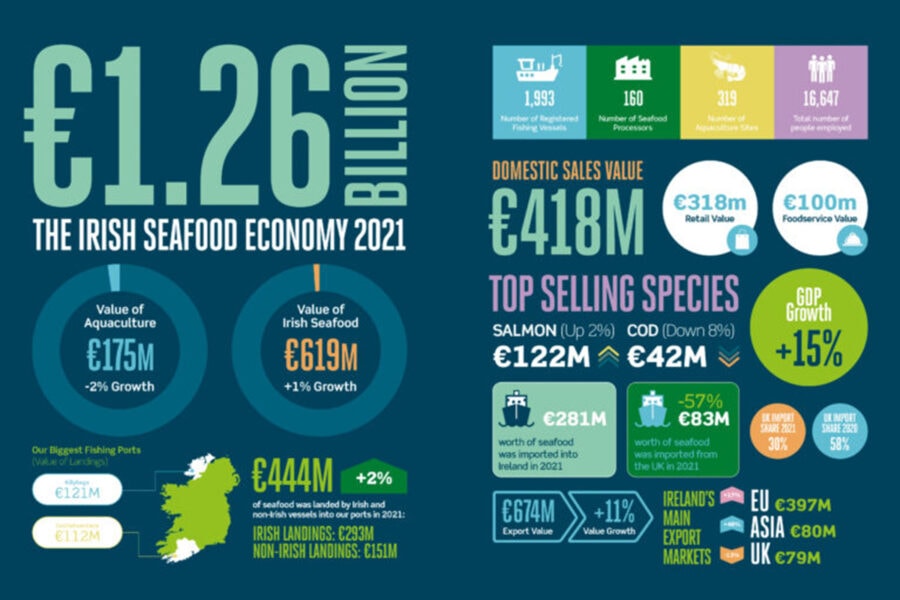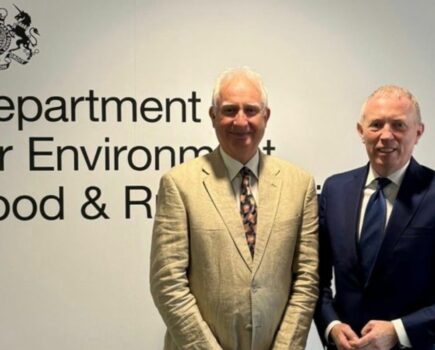A report published by Ireland’s Bord Iascaigh Mhara (BIM) says that the Irish seafood economy grew to a record value of €1.26bn in 2021, reports Paul Scott.
In its annual Business of Seafood Report, BIM says that despite the dual challenges of Brexit and Covid-19, the Irish seafood economy grew by 15% in 2021.
It says that the industry recovered from the trading difficulties of 2020 to record a growth in GDP of 15.3% year on year. The agency says this figure is ‘the highest value seen since 2016’, with growth driven by ‘strong exports to the EU and Asia’ that increased the total value by 11%, to €674m.
The report also says that in 2021, foodservice purchases of seafood in Ireland increased by 12%, following a decline of 53% the previous year. Owing to what the report describes as a ‘partial recovery in the domestic hospitality sector’, domestic consumption grew by 3% to €418m. The report notes that ‘normal operating conditions should see strong growth and recovery in 2022’.
The seafood balance of trade – exports measured against imports – grew by 45%, driven by ‘strong export growth, particularly in EU markets’.
The report says that the reopening of foodservice sectors internationally led to ‘strong price growth in shellfish species such crab, lobster, shrimp and razor clams’ – with prices increasing by over 20%. However, owing to strong competition from countries such as Scotland and Norway, the value of Irish organic salmon on international markets dropped by 14%.
The BIM report adds that government investment in the sector continued to grow during 2021, amounting to €232m, an increase of 11%. It says that support from the European Maritime and Fisheries Fund, along with national investment programmes, ‘contributed to a wide range of projects across all parts of the industry’.
During 2021, private investment increased by €23m, up 5%, to a total of €221m. Overall investment in the sector increased by 8% to €454m, demonstrating what BIM describes as ‘renewed confidence’.
“The key insights from this report are the sector’s success in both identifying and driving opportunities in different markets along with an increase in value for some categories,” said BIM chief executive Jim O’Toole.
The report notes that Ireland has been ‘heavily impacted’ by the transfers of fish quotas under the Trade and Co-operation Agreement (TCA). However, it says that despite a 7% reduction in volumes landed by Irish vessels, the total value of landings grew by 2%, owing to higher prices.
Brexit is also cited as a major factor in changing trading patterns, with the EU becoming the main import market for the first time, and the value of imports from the UK dropping by 57%.
“While Brexit, and the additional impacts of the TCA, reduced quotas for key species, government support along with private investment helped mitigate some of these impacts,” said Jim O’Toole.
Employment in the sector, the report says, remained stable, ‘despite the hurdles encountered’. A total of some 16,650 people were employed directly and indirectly, an increase in overall employment of 1%.
“The industry continues to adapt – for example, in the seafood-tech sector there are now over 50 companies employing more than 700 people from disciplines including engineering, fintech and marketing, and we have seen turnover more than double in the past few years,” said Jim O’Toole.
Despite the record value, the report warns of ‘challenges’ ahead. “Although we have seen significant growth last year, there are further challenges now being encountered with cost increases for fuel, energy, and materials as a result of the conflict in Ukraine.
“Support to the industry to help withstand this economic shock will undoubtedly be required,” said Jim O’Toole.
The full report is available to read here.
This story was taken from the latest issue of Fishing News. For more up-to-date and in-depth reports on the UK and Irish commercial fishing sector, subscribe to Fishing News here or buy the latest single issue for just £3.30 here.








